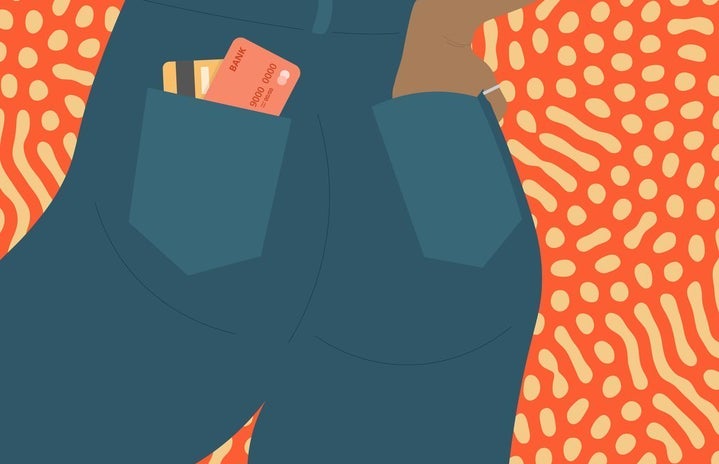Credit- like adulthood- can be an intimidating topic to broach, but first you should start with a credit card. Regardless of whether you’re applying for a car loan, or just buying your weekly groceries- using a credit card can both protect your finances and get you one step closer to feeling like a “grown-up.”
With great power comes great responsibility, and the purchasing power within such a tiny piece of plastic provides the perfect representation of that principle. Unlike that debit card from your first student checking account, a credit card can enable you to earn rewards just by traveling, get frequent cash-back perks, and utilize flexible spending limits. Thus, establishing money management skills and knowing the risk involved with credit card debt are just two of the ways a young college student can become more responsible with their credit.
So, what is credit? Maybe you’re just working out leasing your first off-campus apartment, or you’re moving out of Philadelphia’s urban life and need access to a car. Either way, having good credit will facilitate taking these major steps in life. This is because a credit score basically tells a bank whether you are responsible enough to not borrow more money than you can pay back and that you will pay back the money lent to you on time.
You might be wondering: How can the bank tell if I’m responsible or not? This is done by monitoring your credit history. Your individual account includes the length of your history (the sooner you start the better!), the different types of credit you have in use, how much you currently owe, and your previous payments.
Having an extensive record that illustrates your trustworthiness as an individual will make all the difference in applying for any kind of loan. General guidelines for credit score ratings go as follows: 850-720 is excellent, 719-690 is good, 689-630 is fair, and anything below 629 is poor.
Although these might just look like numbers to you, they tell whoever is lending to you what kind of person you are at a glance. So, you want to make that first impression count. The difference between somebody with a 620 and a 760-credit score may not seem significant. However, the respective interest rates given to a person with a 620 vs. a 760, can vary drastically.
Let’s consider mortgages for a second. If you have poor credit, you will be expected to pay more to borrow the money you need. This is reflected through a loan’s APR (annual percentage rate). Being granted a good APR can mean you’re paying hundreds less on your loan each month- with savings totaling into the tens of thousands range if you’re looking at a 30-year mortgage.
Enough of the fine print. Of course, we have all heard the horror stories of teenagers misusing their credit card as the ticket to a shopping spree. However, the fact of the matter is, if you’re seeking out ways to improve your credit as a young adult, you already understand the gravity of obtaining a good credit score. And chances are, you’re not going to exhibit the careless behavior banks and credit unions look out for.
Now that the significance of credit in your adult life is established- let’s take a look at what student-friendly credit card is right for you.
Discover it Student Cash Back
Rewards Rate: 1%- 5% (5% applies only on qualifying purchases)
Intro APR: 0% (6 months)
Regular APR: 15.24%-24.24%
Pros:
- Absolutely no fees, including annual and foreign transaction fees
- No penalties the first time you pay late
- The issuer will match the cash back you have earned over the course of your first year of use
Cons:
- 5% cash back is only available for preselected rotating category purchases which may be difficult to keep track of
- Does not offer the benefit of purchase or travel protection
Discover it Student Chrome
Rewards Rate: 1%-2%
Intro APR: 0% (6 months)
Regular APR: 15.24%- 24.24%
Pros:
- Unlimited dollar for dollar cash back match in your first year
- An established credit score is not required
- No penalties the first time you pay late
- 0% intro APR for the first six months
Cons:
– Less likely of being accepted internationally, so if you’re planning to travel abroad this is certainly a factor to consider.
Capital One Quicksilver Student Cash Rewards Credit Card
Rewards Rate: 1.5%-8%
Intro APR: N/A
Regular APR: 16.49%-26.49%
Pros:
- No foreign transaction fees, coupled with travel and purchase protections, makes this a great starter card if traveling is your priority.
- Equal rewards to a standard Capital One credit card, minus the need for an extensive credit history
- Above-average cash back rewards rate
Cons:
- Although the card has a variable APR range, the higher end of 26.49% can make paying back a remaining balance more difficult
- Does not offer an introductory rate of 0% APR
Capital One SavorOne Student Cash Rewards Credit Card
Rewards Rate: 1%-8%
Intro APR: 0%
Regular APR: 16.49%-26.49%
Pros
- Great cash back rate for categories like dining and entertainment
- Minimal fees
- Capital One will automatically consider the card holder for a higher line of credit following six months of good credit building.
- $100 cash welcome bonus if you spend $100 in the first three months
Cons
- Does not offer benefits for students specifically
- Potential to have a high APR rate, similar to the Capital One Quicksilver Credit Card.
Petal 2 “Cash Back, No Fees” Visa Credit Card
Rewards Rate: 1%-1.5%
Intro APR: N/A
Regular APR: 15.24%-29.24%
Pros:
- An existing credit score is not necessary to apply
- Absolutely no fees (annual fee, foreign transaction fees, late payment fees, or returned payment fees)
Cons
- The reward structure supplies the user with improved cashback rates after 6 and 12 respective monthly payments are submitted on time. This can be confusing for those starting out building credit.
- Balance transfers are not offered, so this card cannot be used to manage existing debt.
- Like the Capital One Quicksilver credit card, the higher end of the APR range is above much of the competition
Whether you’re looking for high reward rates, travel perks, or minimal fees, there is bound to be a credit-building card that suits your needs. So, apply today, because when you’re both proactive and responsible, independence can offer some amazing benefits.

